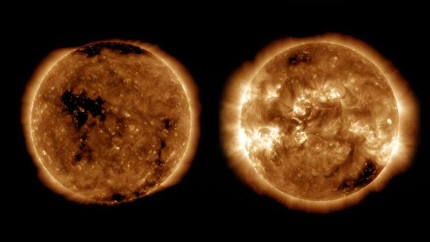Important Facts For Prelims
NASA's STEREO-’s Earth Flyby
- 19 Aug 2023
- 5 min read
Why in News?
In a significant development, NASA's (National Aeronautics and Space Administration) Solar Terrestrial Relations Observatory (STEREO-A) spacecraft has made its first Earth Flyby, nearly 17 years after its initial launch.
- During the Earth flyby, STEREO-A will collaborate with Nasa's Solar and Heliospheric Observatory (SOHO) and Nasa's Solar Dynamics Observatory (SDO), enhancing its observations.
- This collaboration aims to optimize the spacecraft's stereo vision to capture varying-sized solar features at different distances.
What are STEREO-A and STEREO-B?
- STEREO-A (A stands for Ahead), along with its twin STEREO-B (B stands for Behind), was launched in 2006 to study the Sun's Behavior by charting Earth-like orbits around it.
- Their primary goal was to provide a stereoscopic view of the Sun, enabling researchers to study it from multiple perspectives.
- In 2011, STEREO-A achieved a pivotal milestone by reaching a 180-degree separation in its orbit from STEREO-B. This spatial arrangement allowed humanity to observe the Sun as a complete sphere for the first time, offering crucial insights into its complex structure and activity.
- STEREO-B broke contact with mission control in 2014 after a planned reset (B's mission officially ended in 2018).
What is the Purpose of STEREO-A's Earth Flyby?
- Stereoscopic Vision of the Sun:
- STEREO-A's Earth flyby will enable it to once again employ stereoscopic vision, a technique mirroring human depth perception.
- This method involves combining views from different locations to extract 3D information from 2D images of the Sun.
- Scientific Objectives:
- Scientists plan to utilize this opportunity to identify active regions beneath sunspots and uncover 3D information about their structure.
- Additionally, a new theory suggesting that coronal loops may be optical illusions will be tested.
- The flyby also offers insights into the evolution of the magnetic field of Coronal Mass Ejections (CMEs) as they travel towards Earth.
- CMEs, which are bursts of solar material, have the potential to disrupt satellite communications, radio signals, and even impact power grids on Earth.
- By obtaining multipoint measurements from inside a CME, researchers aim to enhance their computer models and predictions about these solar eruptions.
- Solar Activity Dynamics:
- This upcoming flyby will be starkly different from STEREO-A's early days in 2006, because at that time the Sun was in its Solar Minimum phase.
- As the Sun approaches the predicted Solar Maximum for 2025, its heightened activity presents a distinct perspective for STEREO-A's observations.
Note: Solar Maxima and Minima refer to the two phases of the Solar Cycle that occur over an approximately 11-year period. These cycles are characterized by changes in the number of sunspots, solar flares, and other solar phenomena.
- The solar maximum is the phase when the Sun is most active, with many sunspots and intense eruptions.
- The solar minimum is the phase when the Sun is least active, with few or no sunspots and calm surface.
UPSC Civil Services Examination, Previous Year Question (PYQ)
Q. If a major solar storm (solar flare) reaches the Earth, which of the following are the possible effects on the Earth?(2022)
- GPS and navigation systems could fail.
- Tsunamis could occur at equatorial regions.
- Power grids could be damaged.
- Intense auroras could occur over much of the Earth.
- Forest fires could take place over much of the planet.
- Orbits of the satellites could be disturbed.
- Shortwave radio communication of the aircraft flying over polar regions could be interrupted.
Select the correct answer using the code given below:
(a) 1, 2, 4 and 5 only
(b) 2, 3, 5, 6 and 7 only
(c) 1, 3, 4, 6 and 7 only
(d) 1, 2, 3, 4, 5, 6 and 7
Ans: (c)





